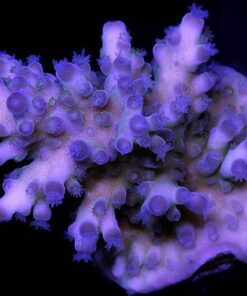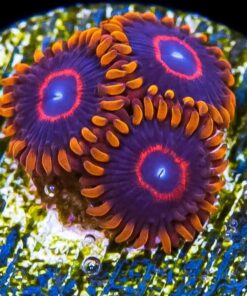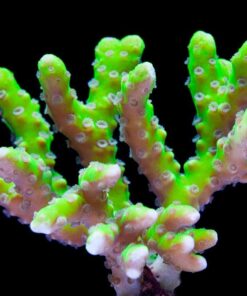1 FRAG of NEON ULTRA GREEN BRANCHING HAMMER
DESCRIPTION
Branching Hammer Coral (Euphyllia sp) is a majestic Neon green color. However the lighting and the hardiness of its coral’s diet do play a significant role in the lushness of the coral’s color. This along with the fact that its tentacles closely resemble hammers make it a wonderful addition to any reef enthusiasts aquarium.
The Hammer Coral (Euphyllia fimbriata) is a large polyp stony (LPS) hard coral that goes by the name of Euphyllia Hammer Coral or Anchor Coral. Its common names are result of the start similarity in appearance it has to a hammer. The Hammer Coral polyps are visible throughout the day and night and hide its skeletal base. The polyps may be green, tan, or brown in color, with lime yellow or green tips on the ends of its tentacles that glow under actinic lighting. Some varieties may be branched which makes them look similar to a Torch Coral (E. glabrescens).
The Hammer Coral is very sensitive and requires proper water conditions in the aquarium, this enables it to thrive and provide a great deal of enjoyment to its owner. At night, its sweeper tentacles can extend up to six inches in the reef aquarium, stinging other species of corals and even endangering the animals within your tank. Obviously the Hammer Coral could be a big danger to other coral colonies in the tank, which is why it is essential to allow plenty of room between it and other neighboring coral colonies.
The Hammer Coral, as well as, all Euphyllia in general, are extremely popular LPS corals (and rightly so). They come in a rainbow of colors that ranges from brown, green, or purple. The Hammer Coral come in two skeleton forms: branching and wall. Each has its own benefit. Branching corals, as the name suggests, have individual polyps (heads) that grow out of a “mother” branch(es). Branching hammer corals tend to grow both upwards and to the sides. Wall hammer corals excrete their skeleton directly on the rock they’re attached to. They only grow to the sides. Branching hammer corals are easier to frag because you can easily cut the polyps off the mother colony on the dead skeleton. It’s impossible to frag a wall hammer without cutting living flesh. This raises the possibility of leaving the wall hammer susceptible to disease. Hammer corals will sting all other corals with their long sweeper tentacles (except other euphyllia), so be wary of that when you start placing your corals. Hammer corals tend to prefer low-medium flow; especially flow that comes from below the tentacles. They seem to be OK with low, medium, or high intensity light: they just need to be acclimated to whatever light you have.
In comprising to other LPS, the Hammer Coral grows at a much faster pace; it retracts at night and opens up when the lights kick on. And the massive tentacles have a waving or flowing like motion and help provide a consistent movement to the tank.
The Hammer Coral are a photosynthetic coral and do not need to be fed directly. By utilizing the light in your tank, this coral produces its own food. The Hammer Coral not only utilizes photosynthesis for nourishment, but will consume meat when its tentacles can capture. It is recommended that you provide your Hammer Coral a small amount of minced meat no more than once a week. This is believed to add to the over-all growth of the colony.
The Hammer Coral and the Anchor Coral are very similar except the Hammer Coral polyps have hammer or “T” shaped tips. Hammer Coral has a straighter and flatter tip, but there can be curvature in the tip.
The colors of the Hammer Coral tentacles can be brown or tan with shinny or green creamy tips. When feeding, the individual tentacles can elongate 2 to 3 times their normal state. Some colonies can reach over 3 feet (1 m).
The ideal water change required for a successful colony of Hammer Coral is of 20 % a month, 10 % biweekly, or 5 % weekly are needed. It has been noted that 5 % weekly water changes replenish many of the needed additives and it is ultimately cheaper than purchasing additives for the water. With higher concentrations of coral with calcareous skeletons though, there may be a need to put in additional additives to maintain proper levels for hearty growth.
Be the first to review “NEON ULTRA GREEN BRANCHING HAMMER” Cancelar respuesta
Related products
Montipora
EUPHYLLIA
EUPHYLLIA
Zoas













Reviews
There are no reviews yet.